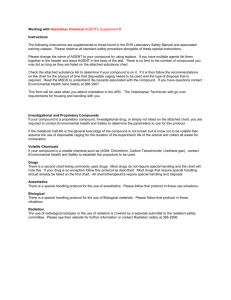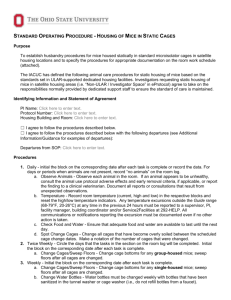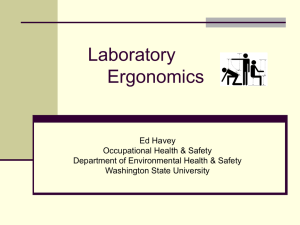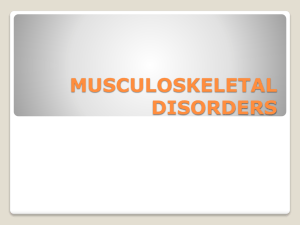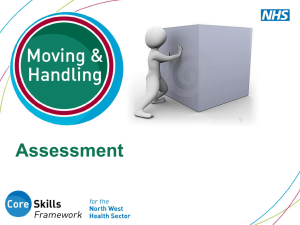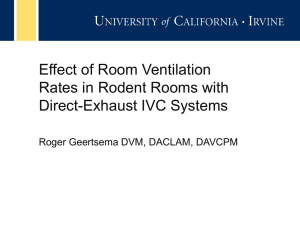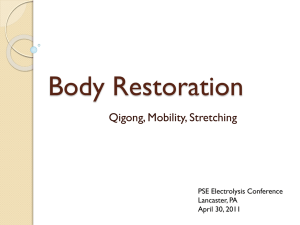Animal Care and Use Ergonomics - Environmental Health & Safety
advertisement
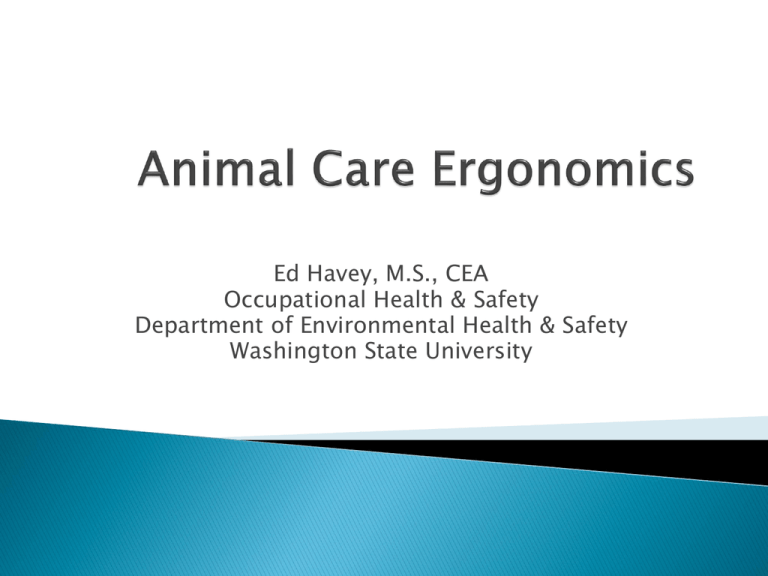
Ed Havey, M.S., CEA Occupational Health & Safety Department of Environmental Health & Safety Washington State University Ergonomics is the science and practice of designing tasks and workplace considering our capabilities and limitations. OR Fitting the work to the person ◦ User ◦ Equipment/Work Space ◦ Tasks Prevention of WMSDs Reduced fatigue and discomfort Increased productivity Improved quality of work Enhanced quality of life WMSDs are soft-tissue injuries to muscles, tendons, ligaments, cartilage, blood vessels and nerves that usually develop gradually. Can be serious, if not taken care of early. Also know as: Cumulative Trauma Disorders (CTDs) Repetitive Strain Injuries (RSIs) Overuse Injuries WMSDs can occur when demands on tissues exceed their capacities. Typically they occur in the moving parts of the body like the neck, back, shoulder, elbow, wrist and knee. Low Back Injury Carpal Tunnel Syndrome Tendonitis Tenosynovitis Epicondylitis De Quervain’s Syndrome Discomfort Fatigue Pain Swelling Loss of ROM Stiff/tight muscles Numbness Tingling Burning Sensations Shooting/Stabbing Pains Weakness in the hands; dropping things Experiencing one or more symptoms does not necessarily mean a person has a WMSD. However, an Incident Report should be completed and a task evaluated when: Symptoms are associated with specific movements/postures and/or tasks Symptoms are chronic Symptoms appear to worsen throughout the work day & week, with some relief in the evenings and on weekends Early modifications to work conditions and practices are more successful Early treatment is more successful Ignoring early symptoms can lead to injuries requiring more intensive treatment Untreated symptoms and injuries might result in permanent disability WMSDs causes are multifactorial. Physical risk factors: Awkward and Static Postures High Hand Forces Highly Repetitive Motions Mechanical/Contact Stress Cold Vibration Combinations of factors Cage Handling Small Animal Handling Large Animal Handling Cart Handling Feed and Bedding Bag Handling Water Bottle Handling Medical & Research Procedures Task Hands/Wrists Lifting animals for cage cleaning Elbows Shoulders Neck Back Legs Lifting cage floors and grating Pushing, pulling, rotating full cage carts Cleaning cages with spray nozzle/scrub brush Lifting feed bags Dispensing food pellets into wire cages Task Hands/Wrists Elbows Shoulders Neck Back Transferring rodents with forceps Handling containers, wire cages, cage lids Preparing, transferring, replenishing water bottles Rodent dosing Lifting feed bags Pushing, pulling, rotating full carts Legs Preventing and responding to WMSDs involves: Designing or modifying the work environment (engineering controls) Modifying tasks (administrative controls) Task variability (administrative controls) User health/fitness Professional Health Care Engineering controls are the preferred control method Ergonomic design specifications should be considered from the inception of all projects to ensure proper facility design and equipment purchases. Specifications can include: rules, checklists or guidelines addressing factors such as reach distances, working heights, forces, and grip dimensions. Good design minimizes exposures to: Awkward and static postures High hand forces Repetitive motions Mechanical/contact stress Prolonged standing Good Design = Desired Actions Common Engineering Controls Large (min. 20 cm) roller bearing casters on movable cages Automatic cage waste disposal, dumping & washing systems Vacuum disposal & delivery for cage bedding Feed bags, cages and other items requiring repeated lifting stored 40-50 cm above the floor (or store feed bags on lift and swivel tables) Adjustable footrests for seated work or foot rails with antifatigue matting for standing work areas Centrally located feed bags (20kg maximum) and all supplies Engineering Controls - Large Animal Tasks Ceiling mounted water systems to reduce lifting forces while spray washing cages Phase out stainless steel cage floors for lightweight aluminum floors/grating with handholds Curved shaft mops and cage scraping tools with upper handle grip Provide as much space as possible in animal housing areas Engineering Controls - Large Animal Tasks Multiple floor drains in animal rooms with easy access for cleaning Smooth transition between rooms, minimize ramps Remove bumps leading to animal rooms and floor drains Advancing back wall (“squeeze”) on cages to minimize animal handling Engineering Controls - Small Animal Tasks Height adjustable (70-115 cm) bio-containment hoods with kneewell clearance Ergonomic forceps with larger grips to minimize finger fatigue 1.2 m maximum shelf height of rodent cages Replace glass water bottles with plastic or install automatic watering systems Engineering Controls - Small Animal Tasks Minimum of 2 m between racks in rodent rooms to improve cart and equipment maneuverability Provide rodent surgeons with adjustable angled rodent tray or support stand for tail bleeding Adjustable extended eyepieces for microscopy work Administrative controls: policies, procedures and practices minimizing exposure of workers to risk. Less effective than engineering controls as they do not eliminate the hazard; however, they: Lessen frequency of exposure Lessen duration of exposure Advantages: cost and feasibility General administrative controls include: Broaden or vary job content Distribute equal workloads among workers Rotate workers through several jobs Schedule more breaks for rest and recovery Adjust work pace to give workers more control of work Training: Work practices and procedures Recognize risk factors Recognize and report WMSD signs and symptoms Participate in identifying and implementing controls Task Development and Variability Developing or modifying tasks depends on 3 interacting factors You (user) Tasks Task variability offers several advantages: Workstation Opportunity to change postures Users will be more alert and productive Different tasks use different muscle groups Provides recovery time and pauses for stretches Tasks with highly repetitive motions and high hand forces can be spread out during the day What physical do you see? risk factors Associated Risk Factors: Static Postures Awkward Postures – neck, head and arms Associated Health Concerns: Sore feet Swelling of the legs Fatigue Low back pain Neck pain Preventative Measures: Proper shoes Change in posture Walking Footrests Sit-stand stools Anti-fatigue mats Computer workstation ergonomic considerations: User Workstation configuration ◦ Chair ◦ Desk & Keyboard/Mouse Tray ◦ Input Devices ◦ Monitor – CRT vs. LCD Tasks Lighting Risk Factors: Health & injury history Lifting, carrying, pulling & pushing Awkward & static postures Object weight Preventative Measures: Engineering controls Maintenance programs Minimize weight/force Proper techniques If you have additional questions or would like to schedule an ergonomic evaluation contact: Ed Havey havey@wsu.edu or 5-5311

